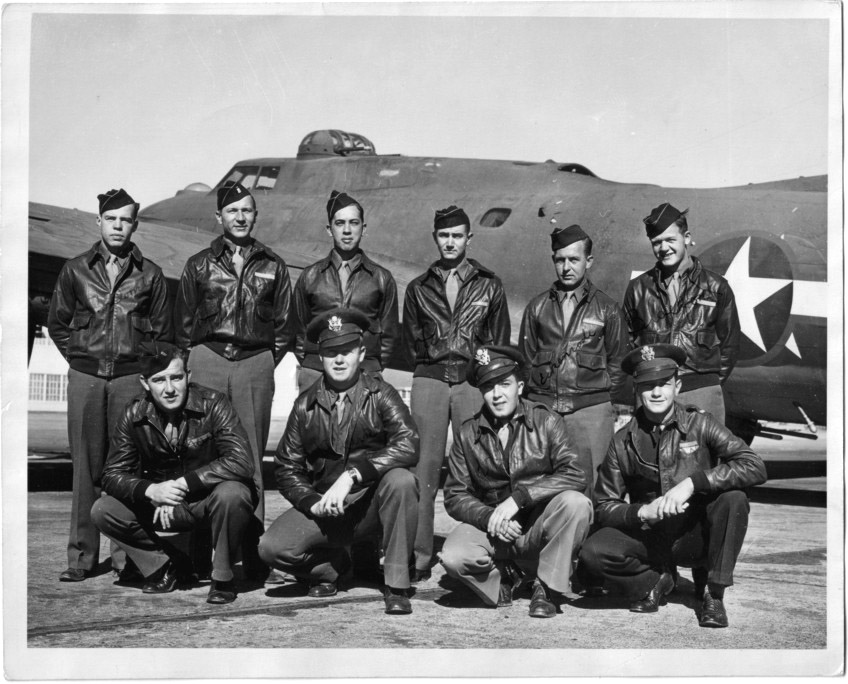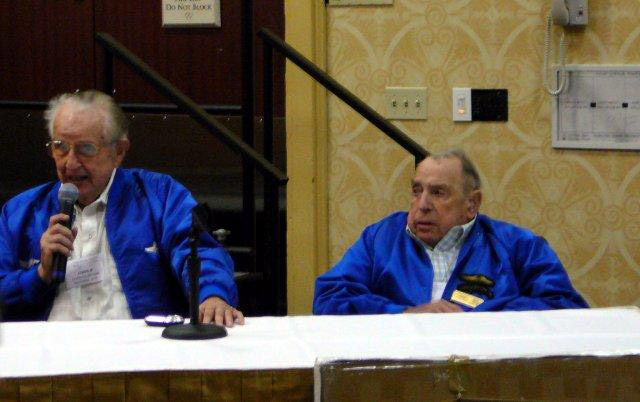|
|
WAR STORIES
This
section contains an assortment of war stories from our
past newsletters “Contrails”.
WHEN
AN ENEMY WAS A FRIEND
Air
Force Magazine/ January 1997
By
John L. Frisbee
Contributing Editor

“Ye Olde Pub”
crew:
Back
row, L-R:
S/Sgt Bertrand O.Coulombe, Engineer/Top
Turret Gunner, Sgt Alex Yelesanko, Left Waist,
Sgt Richard A. Pechout, Radio Operator; Sgt Lloyd H.
Jennings, Right Waist; S/Sgt Hugh S. Eckenrode, Tail
Gunner; Sgt Samuel W. Blackford, Ball Turret
Front
row, L-R:
2nd Lt Charles L. Brown, Pilot; 2nd
Lt Spencer G. Luke, Co-Pilot; 2nd Lt Albert
Sadok, Navigator;
2nd Lt Robert M. Andrews, Bombardier
Brown's
B-17 was perhaps the most heavily damaged bomber to
return from combat. It survived because of an enemy's
act of chivalry.
December 20, 1943, was a typically cold, overcast
winter day in Britain as 2nd Lt. Charles L. Brown's
B-17F lined up for takeoff. It was 21-year-old Charlie
Brown's first combat mission as an aircraft commander
with the 379th Bomb Group, the target an FW-190 factory
at Bremen, Germany. He and his crew of Ye Olde Pub were
to become participants in an event probably unique at
that time in the air war over Europe—a mission that
would remain shrouded in mystery for many years.
The bombers began their 10-minute bomb run at 27,300
feet, the temperature: -60°. Flak was heavy and
accurate. Before "bombs away," Brown's B-17 took hits
that shattered the Plexiglas nose, knocked out the
number two engine, damaged number four—which frequently
had to be throttled back to prevent over speeding—and
caused undetermined damage to the controls. Coming off
target, Lieutenant Brown was unable to stay with the
formation and became a straggler.
Almost immediately, the lone and limping B-17 came under
a series of attacks from 12 to 15 Bf-109s and FW-190s
that lasted for more than 10 minutes. The number three
engine was hit and would produce only half power.
Oxygen, hydraulic, and electrical systems were damaged,
and the controls were only partially responsive. The
bomber's 11 defensive guns were reduced by the extreme
cold to only the two top turret guns and one
forward-firing nose gun. The tail gunner was killed and
all but one of the crew in the rear incapacitated by
wounds or exposure to the frigid air. Lieutenant Brown
took a bullet fragment in his right shoulder.
Charlie Brown figured the only chance of surviving this
pitifully unequal battle was to go on the offensive.
Each time a wave of attackers approached, he turned into
them, trying to disrupt their aim with his remaining
firepower. The last thing oxygen-starved Brown remembers
was reversing a steep turn, becoming inverted, and
looking "up" at the ground. When he regained full
consciousness, the B-17 was miraculously level at less
than 1,000 feet.
Still partially dazed, Lieutenant Brown began a slow
climb with only one engine at full power. With three
seriously injured aboard, he rejected bailing out or a
crash landing. The alternative was a thin chance of
reaching the UK. While nursing the battered bomber
toward England, Brown looked out the right window and
saw a Bf-109 flying on his wing. The pilot waved, then
flew across the B-17's nose and motioned Brown to land
in Germany, which the aircraft commander refused to do.
After escorting them for several miles out over the
North Sea, the Luftwaffe pilot saluted, rolled over, and
disappeared. Why had he not shot them down? The answer
did not emerge for many years.
The B-17 did make it across 250 miles of storm-tossed
North Sea and landed at Seething near the English coast,
home of the 448th Bomb Group, which had not yet flown
its first mission. The crew was debriefed on their
mission, including the strange encounter with the
Bf-109. For unknown reasons, the debriefing was
classified "secret" and remained so for many years.
Lieutenant Brown went on to complete a combat tour,
finish college, accept a regular commission, and serve
in the Office of Special Investigations, with the Joint
Chiefs of Staff, and in other Air Force and State
Department assignments until his retirement. He now
lives in Miami, Fla., where he is founder and president
of an energy and environmental research center.
The image of his strange encounter with the Bf-109
remained firmly embedded in Charlie Brown's memory. In
1986, he began a search for the anonymous pilot.
Finally, in 1990, former Oberleutnant Franz Stigler, now
living in Canada, responded to a notice published in a
newsletter for German fighter pilots. By comparing
time, place, and aircraft markings, it was determined
that Stigler was the chivalrous pilot who had allowed
Brown's crew to live. Not surprisingly, Brown and
Stigler have become close friends.
On that December day in 1943, there had been two
persuasive reasons why Stigler should have shot down
the B-17. First, earlier in the day, he had downed two
four-engine bombers and needed only one more that day to
earn a Knight's Cross. Second, his decision to not
finish off the aircraft was a court-martial offense in
Nazi Germany and if revealed could have led to his
execution. He considered these alternatives while flying
formation with the B-17, "the most heavily damaged
aircraft I ever saw that was still flying." He could see
the wounded aboard and thought, "I cannot kill these
half-dead people. It would be like shooting at a
parachute."
Franz Stigler's act of chivalry has been justly, though
belatedly, honored by several military organizations
here and abroad. On the other hand, Charles Brown was
not decorated for his heroism over Germany, which never
was reported by the 448th Bomb Group at Seething to his
commanders. Such are the fortunes of war and its
aftermath.
Reprinted by permission from AIR FORCE Magazine,
published by the Air Force Association
In 2007,
Charlie submitted a request to the Air Force for the
Silver Star Medal for his nine crewmembers of “Ye
Olde Pub” for their mission to Bremen, Germany. The
citations were awarded in early 2008, and Charlie was
awarded the Air Force Cross. No other WWII aircrew has
this distinction.

Charlie Brown and Franz Stigler
Their appearance together at our Seattle reunion in
2006.
They both passed away in 2008;
Franz, in March, and Charlie, in November.
|